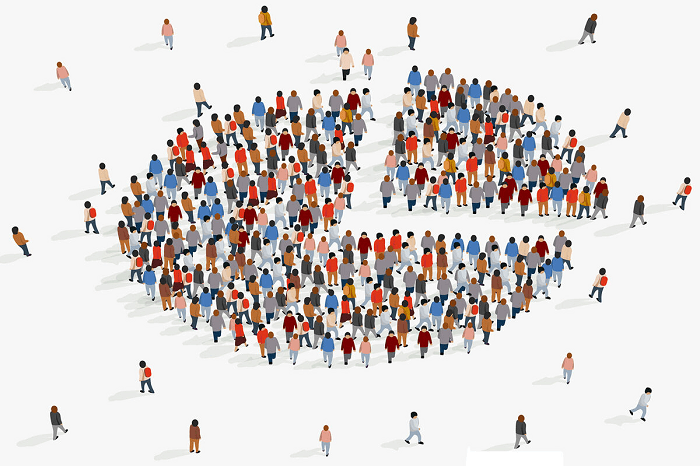Demographics DefinitionDemographics are defined as the features of the general population that have been classified according to specific criteria, such as age, gender, and income, to research a particular group's characteristics. 
Demographics MeaningThe various characteristics of a population are known as its demographics. Age, sex, and race are a few examples of demographics for the population under analysis. Statistics about the socioeconomic conditions of the population are known as demographic statistics. Businesses, organizations, and governments must analyse demographic data in order to make decisions. To make decisions, businesses, organizations, and governments must study demographic data. Both businesses and governments can utilize this information to create marketing strategies and implement public programs. Parameters of DemographicsThe examples below demonstrate how specific data about a population's traits may be included in demographic data:
Demographics Analysis UsageThe dimensions & dynamics of populations are examined and measured in demographic analysis, which can be used for entire societies or specific groups based on factors like education, nationality, religion, & ethnicity. Despite several independent departments of demography, educational institutions frequently treat demography as a branch of sociology. Although originally designed to study human populations, these techniques are now used in a wide range of fields where researchers are interested in how populations of social actors might change over time as a result of processes such as birth, death, and migration. The demographic analysis employs administrative data to create a fair population estimate in the context of the biological populations of humans. Estimates from demographic analyses are frequently regarded as a trustworthy yardstick for assessing the veracity of census data collected at any given time. In population ecology, the emphasis is on the birth, death, migration, as well as immigration of people within a population of living organisms. On the other hand, the movement of businesses and institutional forms may be utilized into consideration in the human social sciences. Demographic analysis is used to figure out the sizes & migration of worker populations within the labour force. Numerous situations call for the application of demographic analysis. For instance, it is frequently used in business planning to indicate the population associated with the business's location. The term "demographic analysis" or "DA" is frequently used. The U.S. Census Bureau has increased the scope of its DA categories for the 2010 census. The 2010 U.S. Census also contains a comparative analysis between census address lists and independent housing estimates at various critical time points. 
Techniques for Obtaining Demographic DataThere are various popular techniques for gathering demographic information. The most widely used methods are as follows: 1. Polls and surveysBusinesses may perform customer surveys or polls to learn more about what customers buy, the reasons behind their shopping habits, and the average amount they spend. A business can gather demographic data by monitoring its social media profiles and online store. As consumers become more comfortable sharing a range of personal information online, online forms & electronic marketing can be utilised to collect more precise and relevant data. 2. Census data collectionThe direct method of acquiring demographic information includes locating and examining public records of births and deaths, marriages and funerals, divorces, and migrations. The Indian government also conducts routine surveys and statistical data collection every year, in addition to ten-year population counts. 3. Online pollsSince conducting online surveys is convenient and inexpensive, collecting demographic data online is becoming more and more popular. Due to this single-mode approach's limitations for simple random sampling of the general population as a whole, alternative methodologies, such as mixed-mode polls, can be paired for better representation. 4. Focus sessionsFocus groups are a great method for acquiring demographic data for a certain product or service. Focus groups are frequently used to investigate the responses of members of specific demographic groups to a good or service. This method is excellent for getting important participant feedback that might help a company before it releases a product or service. 5. Research on attitudes or the mindThis method looks into a customer's psychological motivations for making a purchase as well as their general demographics. This kind of study can be used to obtain information on consumer purchasing patterns, value systems, and interests, attitudes about a particular commodity or service, and a number of other psychological aspects that affect a person's decision to buy something or not. Collection of Demographic DataThe statistical & mathematical study of demography examines the size, makeup, and the geographical distribution of human populations as well as how these characteristics evolve through time. Records of occurrences, including births, deaths, migrations, marriages, divorces, illnesses, and jobs, are gathered from registries as well as data from population censuses. Understanding all four elements of population change, uniformity of population figures, the demographic accounting equation, and population composition, as well as how they are calculated and the issues they address, is required in order to do this. There are various strategies for each of the two categories of data collection: direct and indirect. Direct techniquesVital statistics databases, which record every birth and death, and some changes in legal existence, including marriage, divorce, & migration, offer direct data. In developed countries with effective birth- and death-registration systems, registry statistics are an incredibly reliable method of estimating the total number of births and fatalities. A census is another common direct method for acquiring demographic data. Often, a country's national government will conduct a census, which tries to count every person living there. Since they frequently only occur every decade or so, censuses are not necessarily the most reliable source of information on events such as births and deaths. Contrarily, data for vital statistics are normally continuously gathered and summed once a year. The analysis is carried out following a census to ascertain the degree of undercounting or overcounting. These compare the sex ratios obtained from the census records with those anticipated from mortality and natural value statistics. More than just people are enumerated during a census. They frequently collect information on families or households in addition to data on individual characteristics like age, sex, relationship status, knowledge/education, employment status, occupation, and location. Additionally, they might collect data on nationalities like ethnicity or race, citizenship, language, religion, nations such language and race, and migration like a place of birth or prior residence. In countries where the vital registration process may not be trustworthy, censuses are also utilized as a direct source for data regarding fertility and mortality. 
Indirect techniquesIt is necessary to adopt indirect ways of data collecting when complete data are not accessible, as is the situation for the vast majority of historical demographics and a large portion of the developing world. One of these modern demography techniques is the sister method, in which investigators conducting surveys ask women the number of their siblings have died or given birth and at what age. Using these surveys, researchers may then determine the birth and mortality rates in the community. Another deceptive technique used in contemporary demographics is to inquire about people's parents, children, and siblings. Additional indirect strategies are needed for historical demography. For population processes, there are several demographic modelling tools. Models for fertility include the Hermes model, Coale-Trussell models, and parity progression ratios. Models for marriage include the Singulate Mean at Marriage and Page models. In the United Kingdom, four national birth cohort studies have been conducted, with the "National Survey of Health and Development beginning in 1946, the National Child Development Study beginning in 1958, the British Cohort Study beginning in 1970, and the Millennium Cohort Study beginning much more recently in 2000. The first three cohort studies were separated by 12 years. These have tracked the lives of samples of individuals for many years and are still going strong, usually starting with 17,000 in each research. These studies can be used to derive conclusions about the variations between four different generations of British people in terms of their health, education, attitudes, childbearing, and work patterns because the samples were collected in a nationally representative manner. When a population is sufficiently small that there are few occurrences (births, deaths, etc.), indirect standardization is utilized. A standardized mortality rate (SMR) or standardized incidence rate (SIR) must be generated in this situation.
Next TopicEpithelial Tissue Definition
|
 For Videos Join Our Youtube Channel: Join Now
For Videos Join Our Youtube Channel: Join Now
Feedback
- Send your Feedback to [email protected]
Help Others, Please Share










